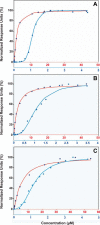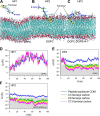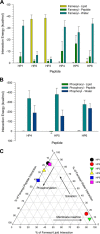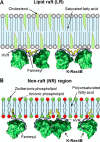Mechanisms of membrane binding of small GTPase K-Ras4B farnesylated hypervariable region
- PMID: 25713064
- PMCID: PMC4392252
- DOI: 10.1074/jbc.M114.620724
Mechanisms of membrane binding of small GTPase K-Ras4B farnesylated hypervariable region
Abstract
K-Ras4B belongs to a family of small GTPases that regulates cell growth, differentiation and survival. K-ras is frequently mutated in cancer. K-Ras4B association with the plasma membrane through its farnesylated and positively charged C-terminal hypervariable region (HVR) is critical to its oncogenic function. However, the structural mechanisms of membrane association are not fully understood. Here, using confocal microscopy, surface plasmon resonance, and molecular dynamics simulations, we observed that K-Ras4B can be distributed in rigid and loosely packed membrane domains. Its membrane binding domain interaction with phospholipids is driven by membrane fluidity. The farnesyl group spontaneously inserts into the disordered lipid microdomains, whereas the rigid microdomains restrict the farnesyl group penetration. We speculate that the resulting farnesyl protrusion toward the cell interior allows oligomerization of the K-Ras4B membrane binding domain in rigid microdomains. Unlike other Ras isoforms, K-Ras4B HVR contains a single farnesyl modification and positively charged polylysine sequence. The high positive charge not only modulates specific HVR binding to anionic phospholipids but farnesyl membrane orientation. Phosphorylation of Ser-181 prohibits spontaneous farnesyl membrane insertion. The mechanism illuminates the roles of HVR modifications in K-Ras4B targeting microdomains of the plasma membrane and suggests an additional function for HVR in regulation of Ras signaling.
Keywords: Cooperativity; HVR; Membrane Microdomains; Phospholipid; Phosphorylation; Post-translational Modification (PTM); Protein Isoprenylation.
© 2015 by The American Society for Biochemistry and Molecular Biology, Inc.
Figures









Similar articles
-
The higher level of complexity of K-Ras4B activation at the membrane.FASEB J. 2016 Apr;30(4):1643-55. doi: 10.1096/fj.15-279091. Epub 2015 Dec 30. FASEB J. 2016. PMID: 26718888 Free PMC article.
-
Flexible-body motions of calmodulin and the farnesylated hypervariable region yield a high-affinity interaction enabling K-Ras4B membrane extraction.J Biol Chem. 2017 Jul 28;292(30):12544-12559. doi: 10.1074/jbc.M117.785063. Epub 2017 Jun 16. J Biol Chem. 2017. PMID: 28623230 Free PMC article.
-
GTP Binding and Oncogenic Mutations May Attenuate Hypervariable Region (HVR)-Catalytic Domain Interactions in Small GTPase K-Ras4B, Exposing the Effector Binding Site.J Biol Chem. 2015 Nov 27;290(48):28887-900. doi: 10.1074/jbc.M115.664755. Epub 2015 Oct 9. J Biol Chem. 2015. PMID: 26453300 Free PMC article.
-
The Hypervariable Region of K-Ras4B Governs Molecular Recognition and Function.Int J Mol Sci. 2019 Nov 14;20(22):5718. doi: 10.3390/ijms20225718. Int J Mol Sci. 2019. PMID: 31739603 Free PMC article. Review.
-
The disordered hypervariable region and the folded catalytic domain of oncogenic K-Ras4B partner in phospholipid binding.Curr Opin Struct Biol. 2016 Feb;36:10-7. doi: 10.1016/j.sbi.2015.11.010. Epub 2015 Dec 20. Curr Opin Struct Biol. 2016. PMID: 26709496 Free PMC article. Review.
Cited by
-
Nanodiscs in Membrane Biochemistry and Biophysics.Chem Rev. 2017 Mar 22;117(6):4669-4713. doi: 10.1021/acs.chemrev.6b00690. Epub 2017 Feb 8. Chem Rev. 2017. PMID: 28177242 Free PMC article. Review.
-
High-Affinity Interaction of the K-Ras4B Hypervariable Region with the Ras Active Site.Biophys J. 2015 Dec 15;109(12):2602-2613. doi: 10.1016/j.bpj.2015.09.034. Biophys J. 2015. PMID: 26682817 Free PMC article.
-
The structural basis for Ras activation of PI3Kα lipid kinase.Phys Chem Chem Phys. 2019 Jun 5;21(22):12021-12028. doi: 10.1039/c9cp00101h. Phys Chem Chem Phys. 2019. PMID: 31135801 Free PMC article.
-
Arl2-Mediated Allosteric Release of Farnesylated KRas4B from Shuttling Factor PDEδ.J Phys Chem B. 2018 Aug 2;122(30):7503-7513. doi: 10.1021/acs.jpcb.8b04347. Epub 2018 Jul 18. J Phys Chem B. 2018. PMID: 29961325 Free PMC article.
-
AMPK and Endothelial Nitric Oxide Synthase Signaling Regulates K-Ras Plasma Membrane Interactions via Cyclic GMP-Dependent Protein Kinase 2.Mol Cell Biol. 2016 Nov 28;36(24):3086-3099. doi: 10.1128/MCB.00365-16. Print 2016 Dec 15. Mol Cell Biol. 2016. PMID: 27697864 Free PMC article.
References
-
- Friday B. B., Adjei A. A. (2005) K-ras as a target for cancer therapy. Biochim. Biophys. Acta 1756, 127–144 - PubMed
-
- Ellis C. A., Clark G. (2000) The importance of being K-Ras. Cell. Signal. 12, 425–434 - PubMed
-
- Esteban L. M., Vicario-Abejón C., Fernández-Salguero P., Fernández-Medarde A., Swaminathan N., Yienger K., Lopez E., Malumbres M., McKay R., Ward J. M., Pellicer A., Santos E. (2001) Targeted genomic disruption of H-ras and N-ras, individually or in combination, reveals the dispensability of both loci for mouse growth and development. Mol. Cell. Biol. 21, 1444–1452 - PMC - PubMed
-
- Koera K., Nakamura K., Nakao K., Miyoshi J., Toyoshima K., Hatta T., Otani H., Aiba A., Katsuki M. (1997) K-ras is essential for the development of the mouse embryo. Oncogene 15, 1151–1159 - PubMed
-
- Plowman S. J., Williamson D. J., O'Sullivan M. J., Doig J., Ritchie A. M., Harrison D. J., Melton D. W., Arends M. J., Hooper M. L., Patek C. E. (2003) While K-ras is essential for mouse development, expression of the K-ras 4A splice variant is dispensable. Mol. Cell. Biol. 23, 9245–9250 - PMC - PubMed
Publication types
MeSH terms
Substances
Grants and funding
LinkOut - more resources
Full Text Sources
Other Literature Sources
Molecular Biology Databases
Miscellaneous

